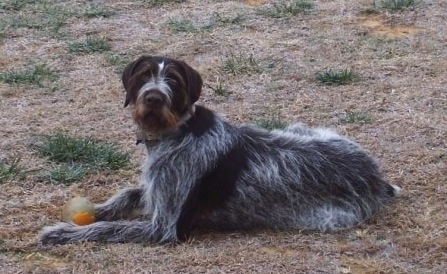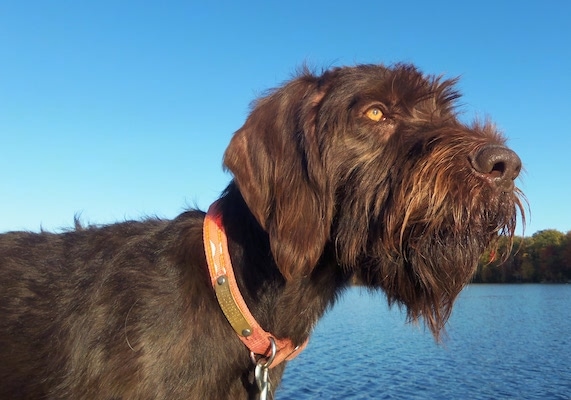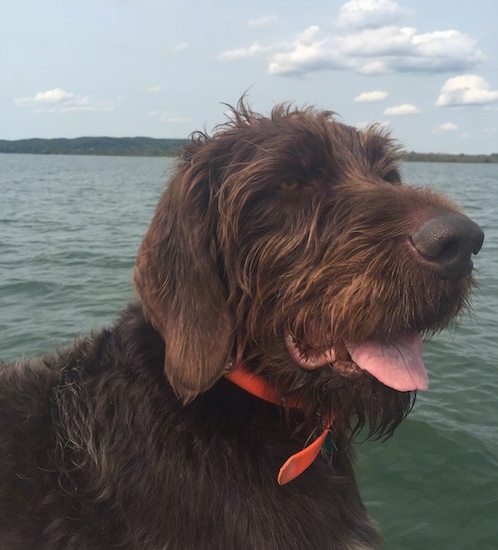
Elk vom Stueth aka Ranger the Deutsch Drahthaar
--
The Deutsch Drahthaar is a medium-sized, well-muscled dog. The body is a little longer than it is tall. The skull is broad with a moderate stop. The muzzle is long and straight leading to the dark brown nose. The medium-sized, oval eyes are brown, with medium length eyebrows. The ears are rounded, hanging close to the head. The teeth meet in a scissors bite. The neck is strong and slender. The chest is deep and wide. Dewclaws are usually removed. The high-set tail is docked to two-fifths of its original length. Note: Docking tails is illegal in most parts of Europe. The coat has an undercoat that is dense in the winter and thin in the summer. The weather-resistant, water-repellent, wiry outer coat is straight, lying flat and harsh about 2 inches (5.8 cm) long. Hair on the beard, forehead and whiskers is slightly longer to protect the face. The coat colors are liver and white, either with ticking, roan or spotted and sometimes a solid liver. The head is liver, with or without a white blaze and the ears are liver.
The Deutsch Drahthaar is very active and intelligent. Eager to learn and loyal to its family, it needs a handler who is consistent in approach. The Drahthaar likes to be occupied and enjoys working for its owner. It is friendly with those it knows, but can be distant with strangers and should be socialized, preferably at an early age. If it senses its owner is meek or passive it will become rather willful. Its hunting instincts lure it to roam. Powerful and energetic, the Drahthaar can become bored and hard to manage without enough exercise. The Deutsch Drahthaar is a good all-around gundogable to hunt any sort of game on any sort of terrain. This dog has a good nose and can track, point and retrieve on both land and water. It is steady, lively and vigorous. Children should be taught how to display proper leadership skills. If this dog does not see humans as above it in the pecking order it will become dominating and pushy and may try to dominate other animals. With proper leadership it will get along well with other dogs and household animals. Drahthaars make good watchdogs.
Height: Males 24 - 26 inches (60 - 67 cm) Females 22 - 24 inches (56 - 62 cm)
Weight: 60 - 70 pounds (27 - 32 kg)
Some lines are prone to hip dysplasia, ear infections, genetic eye disease and skin cancers.
The Deutsch Drahthaar is not recommended for apartment life. It can be somewhat high strung and very active indoors; needs plenty of exercise to prevent extreme indoor restlessness. It will do best with at least a large yard.
This dog is extremely energetic and tireless. It is very important that it gets daily vigorous exercise to prevent it from becoming high-strung with extreme indoor restlessness. This breed can be a challenge for even the most active family and they should not be taken on as a family pet unless they can guarantee plenty of daily vigorous exercise. The breed does best when working, but if that is not possible it needs to be taken on a daily, brisk, long walk, jog or run alongside you when you bicycle. They are excellent jogging companions and love to swim and retrieve. While out on a walk or jog, be sure to make the dog heel beside or behind the person holding the lead, never in front, as instinct tells a dog the leader leads the way, and that leader needs to be the human.
About 12-14 years.
About 4 to 6 puppies
The coat of the Deutsch Drahthaar should be brushed about twice a week with a firm bristle brush. The coat needs some stripping, but is not hard to learn how to do. The hairs should be hand plucked occasionally depending on the condition of the coat. It is usually thinned in the spring and fall. Bathe only when necessary. The hair of the coat should be as hard as possible, but must not look untidy. Check the ears to make sure they are clean. The feet should be checked after the dog has been out working. This breed is an average shedder.
The Deutsch Drahthaar was developed in Germany in the beginning of the 20th century by crossing the German Shorthair Pointer with the Griffon, Stichelhaar (a dog that was developed by crossing the Pointer, Foxhound, Pudelpointer, and Polish water dog) and the Pudelpointer (a dog that was a cross between the Poodle and Pointer). The German Wirehaired Pointer originated from the Deutsch Drathaar. The split occurred when they were imported to the US in the early 50s. At that time the US breeder hopefuls found the regulations of the Verein Deutsch Drahthaar (VDD) the German Breed Club that controls the breed worldwide to be to restrictive. While they could breed the dogs, they could not be registered so they could not sell them as pure bred or registered dogs. They worked through the American kennel Club to get the breed added for the purpose of being able to register their dogs. As an example, Deutsch Drathaar's still can not be bred in the UK. Any litter born of a Deutsch Drathaar pairing in the UK can be registered with their kennel club, however will not be registered with the VDD. The main difference between the Deutsch Drahthaar and the German Wirehaired Pointer is that the Deutsch Drahthaar is still bred to the standards that were established more than 100 years ago when the German breeders determined that they had cultivated the most proficient versatile hunting dog around. The breeding program and requirements for participating, have helped to ensure that genetic defects are not bred back into the breed and that the traits for which the breed was developed are maintained. The GWP has it's own standard with a lot of the concentration being on the show ring and less on the natural desire/drive for the pursuit of game. Deutsch Drahthaar are able to point, track, retrieve, and work as a gundog, in both field and water for both feather and fur.
Gun Dog, Hunting

Griffin vom Elchertz the Deutsch Drahthaar at 5 years old

Griffin vom Elchertz the Deutsch Drahthaar at 5 years old